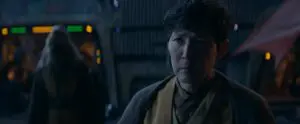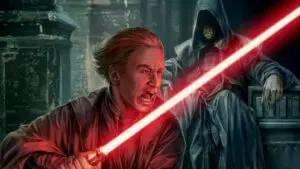Summary
The Acolyte gets off to a decent start with a two-part premiere that introduces a compelling enough central mystery, even if the series overall doesn’t feel as different as advertised.
The Acolyte is the first bit of live-action Star Wars storytelling not to be part of the Skywalker saga, a very contained span of galactic history spanning about 70 years and featuring characters that, by this point, everyone is very, very familiar with. Episodes 1 & 2, “Lost/Found” and “Revenge/Justice”, debuted together on Disney+ in an ambitious twofer intended to establish this show as the most fresh-feeling and diverse entry in the franchise.
To be fair, it is the most diverse Star Wars thing I’ve seen, in front of and behind the camera. Of course, this means that a lot of Star Wars fans already hated it before the premiere and still hate it after two inoffensive episodes that, unfortunately, aren’t as fresh-feeling as probably intended.
If I’m being honest I don’t care that The Acolyte Episodes 1 & 2 feel, at least to me, like any other Star Wars show. I like Star Wars under Disney, for the most part, and similarly, I like The Acolyte, which abandons most of its efforts at being distinct within this two-part premiere. What starts out as an intriguing murder mystery almost immediately becomes a story of a vengeful apprentice being trained by a sinister and secretive dark lord – like usual, then.
Episode 1, “Lost/Found”, starts out promisingly enough. That apprentice, who after a bit of speculation turns out to be Mae Aniseya and not protagonist Osha, the former’s twin sister, confronts a Jedi named Master Indara, played by Carrie Anne Moss in a much-hyped “Trinity but with a lightsaber” role that lasts about five minutes.
Yes, The Acolyte kills Indara off immediately in a Wuxia-inspired hand-to-hand duel, setting up the early season plot – Mae is out for revenge on a few key Jedi Masters who were involved in her tragic backstory, and she has been trained and set on this path by an as-yet unrevealed dark lord, presumably a Sith.
But more on that in a bit. This opening feels very Star Wars to me, from the opening crawl to the music to the cantina setting and a few nodding bits of dialogue. It feels similarly familiar when we transition to Osha’s perspective. For a while the script toys with the idea of Osha perhaps being guilty of the murder – we don’t know at this point that she has a twin – but it’s clearly only using the angle for exposition’s sake.
Osha is a former Jedi, so a current Knight and old friend of hers named Yord arrives to accuse her of murder while also conveniently recounting her entire backstory for the audience’s sake. She left the Jedi Order six years ago and has been eking out a living since by carrying out all the dangerous exterior ship repairs that R2 droids typically do in the Skywalker saga. She had struggled as a Padawan due to being accepted as Jedi much too late after the traumatic deaths of her entire family – mothers and, as far as she knows, sister – in a fire on her home world of Brendok, which is why she now has a phobia of fire.
Episode 1 of The Acolyte maintains the illusion of Osha potentially being guilty for most of its runtime, through an action sequence aboard a crashing prison ship, until we’re introduced to Jedi Master Sol. Osha was once Sol’s Padawan and thus he immediately intuits that something else is going on, which to be fair was obvious to the audience anyway since Osha is flagrantly a Star Wars hero in basically every respect.
Likewise, Sol is a classic Jedi who has internalized considerable guilt about the deaths of Osha’s family, which he was present for, and her leaving the Order. It’s he who reveals that Osha has a sister, which is when the penny drops for the audience that Mae is the guilty party, and he has the good sense to deliver a bit more exposition.
Episode 2 of The Acolyte, “Revenge/Justice”, is a little better, a little shorter, and a little less burdened by introductory responsibilities, though it is characteristically tight-lipped about the identity of the Sith Lord glimpsed at the end of Episode 1.
Here, Sol has taken over the investigation into Mae’s killing spree to preserve the Order’s political optics, and it takes them – he, Osha, Yord, and Sol’s current Padawan, Jecki – to Olega, where Mae has just tried to assassinate her second target, Master Torbin.
Torbin, who looks far too young to have been communing with the Force for ten years solid, is trying to salve a guilty conscience relating to Mae’s backstory. She tries to kill him twice. The first time, she’s thwarted by an invisible Force barrier. The second time she acquires some bunta poison – native to her home world of Brendok – from a fixer accomplice named Qimir, and Torbin voluntarily takes it moments before Sol and the others are due to arrive. Whatever happened on Brendok, Torbin feels so guilty about it that he sulked for a decade and then killed himself.
This is obviously the big underlying mystery of The Acolyte, and it’s likely something that’ll shake the very foundations of what the Jedi believe themselves and their role in the galaxy to be. It also means that Sol is on Mae’s target list, as is a Wookie Jedi named Kelnacca. Whether Mae’s Master is directly connected to this event or is simply using Mae’s grief and anger to his own ends remains to be seen, though it’s probably the latter.
As we learn close to the end of Episode 2, Mae herself doesn’t even know who her master is. Sol fights her in a nice re-do of her opening duel against Indara, and while they’re scrapping he probes her mind for clues about whose bidding she’s doing. But despite Mae not being a match for Sol – I like how he doesn’t fall for the same trick that led to Indara’s death – she’s able to resourcefully escape from the Jedi in a cloud of sand. Osha, who has a clear shot at her with a stun blaster, seems to deliberately miss to allow her to escape.
There’s still a great deal we don’t know about The Acolyte after Episodes 1 & 2, but that’s to be expected in a two-part premiere. These episodes were about getting us on the hook, and thanks to the cast, the cool fights, and the interesting underlying mystery, I’d say the show has done that for the most part.
RELATED:




